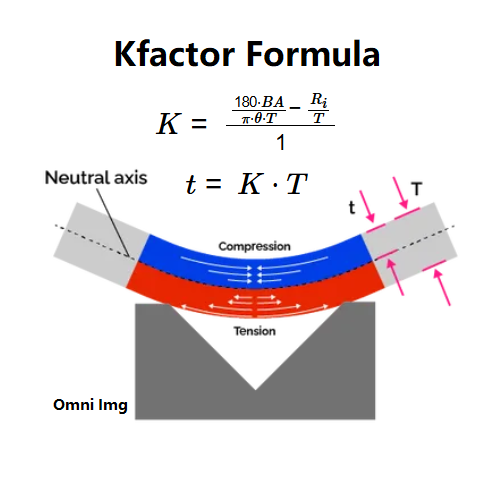1. What is K-Factor Calculator?
Definition: This calculator computes the K-factor for a metal sheet bending process, which indicates the position of the neutral axis, and the distance of the neutral axis from the inner surface (\( t \)).
Purpose: It assists users in sheet metal fabrication by determining the K-factor and neutral axis position, essential for accurate bend allowance calculations and flat pattern development.
2. How Does the Calculator Work?
The calculator uses the following equations:
- \( K = \frac{\frac{180 \cdot BA}{\pi \cdot \theta \cdot T} - \frac{R_i}{T}}{1} \)
- \( t = K \cdot T \)
Where:
- \( K \): K-factor (dimensionless);
- \( T \): Material thickness (converted to mm for calculation);
- \( R_i \): Inner radius (converted to mm for calculation);
- \( \theta \): Bend angle in degrees;
- \( BA \): Bend allowance (converted to mm for calculation);
- \( \pi \approx 3.14159 \);
- \( t \): Distance of the neutral axis from the inner surface (converted to the selected output unit: mm, cm, m, in, ft).
Steps:
- Enter the material thickness (\( T \)) and its unit (mm, cm, m, in, ft).
- Enter the inner radius (\( R_i \)) and its unit.
- Enter the bend angle (\( \theta \)) in degrees.
- Enter the bend allowance (\( BA \)) and its unit.
- Convert all measurements to millimeters.
- Calculate the K-factor: \( K = \frac{\frac{180 \cdot BA}{\pi \cdot \theta \cdot T} - \frac{R_i}{T}}{1} \).
- Calculate the neutral axis distance: \( t = K \cdot T \), in millimeters.
- Convert the neutral axis distance to the selected output unit (mm, cm, m, in, ft).
- Display results: K-factor and neutral axis distance, formatted in scientific notation if the absolute value is less than 0.001, otherwise with 4 decimal places.
3. Importance of K-Factor Calculation
Calculating the K-factor is crucial for:
- Accurate Fabrication: Ensures precise flat pattern development for sheet metal bending.
- Material Efficiency: Minimizes material waste by accurately predicting bend allowances.
- Design Precision: Helps engineers and fabricators achieve the desired dimensions after bending.
4. Using the Calculator
Example 1 (Omni Calculator Example): Calculate the K-factor for a metal sheet:
- Material Thickness: 1 mm;
- Inner Radius: 1 mm;
- Bend Angle: 90°;
- Bend Allowance: 2.1 mm;
- K-Factor: \( K = \frac{\frac{180 \cdot 2.1}{\pi \cdot 90 \cdot 1} - \frac{1}{1}}{1} \);
- \( K = \frac{\frac{378}{\pi \cdot 90} - 1}{1} \approx \frac{1.337 - 1}{1} = 0.337 \);
- Neutral Axis Distance: \( t = 0.337 \times 1 = 0.337 \, \text{mm} \);
- Convert to cm: \( t = 0.337 / 10 = 0.0337 \, \text{cm} \);
- Result: K-Factor = 0.3370, Neutral Axis Distance = 0.0337 cm.
Example 2 (Different Units): Calculate the K-factor for a metal sheet:
- Material Thickness: 0.1 in;
- Inner Radius: 0.2 in;
- Bend Angle: 45°;
- Bend Allowance: 0.157 in;
- Convert to mm: \( T = 0.1 \times 25.4 = 2.54 \, \text{mm} \), \( R_i = 0.2 \times 25.4 = 5.08 \, \text{mm} \), \( BA = 0.157 \times 25.4 = 3.9878 \, \text{mm} \);
- K-Factor: \( K = \frac{\frac{180 \cdot 3.9878}{\pi \cdot 45 \cdot 2.54} - \frac{5.08}{2.54}}{1} \);
- \( K = \frac{\frac{717.804}{\pi \cdot 45 \cdot 2.54} - 2}{1} \approx \frac{2 - 2}{1} = 0 \);
- Neutral Axis Distance: \( t = 0 \times 2.54 = 0 \, \text{mm} \);
- Convert to inches: \( t = 0 / 25.4 = 0 \, \text{in} \);
- Result: K-Factor = 0.0000, Neutral Axis Distance = 0.0000 in.
5. Frequently Asked Questions (FAQ)
Q: What is the K-factor?
A: The K-factor is a ratio that represents the position of the neutral axis during sheet metal bending, typically between 0 and 1.
Q: Why is the neutral axis important?
A: The neutral axis is the layer within the material that neither stretches nor compresses during bending, crucial for calculating accurate bend allowances.
Q: Can this calculator handle complex bending scenarios?
A: This calculator assumes a single bend with constant thickness and radius. For complex bends, you may need to calculate each segment separately.
 Home
Home
 Back
Back
